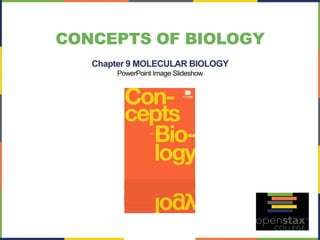
Open stax biology(nonmajors) ch09
- 1. CONCEPTS OF BIOLOGY Chapter 9 MOLECULAR BIOLOGY PowerPoint Image Slideshow
- 2. FIGURE 9.1 Dolly the sheep was the first cloned mammal.
- 3. FIGURE 9.2 Pioneering scientists (a) James Watson and Francis Crick are pictured here with American geneticist Maclyn McCarty. Scientist Rosalind Franklin discovered (b) the X-ray diffraction pattern of DNA, which helped to elucidate its double helix structure. (credit a: modification of work by Marjorie McCarty; b: modification of work by NIH)
- 4. FIGURE 9.3 (a) Each DNA nucleotide is made up of a sugar, a phosphate group, and a base. (b) Cytosine and thymine are pyrimidines. Guanine and adenine are purines.
- 5. FIGURE 9.4 DNA (a) forms a double stranded helix, and (b) adenine pairs with thymine and cytosine pairs with guanine. (credit a: modification of work by Jerome Walker, Dennis Myts)
- 6. FIGURE 9.5 The difference between the ribose found in RNA and the deoxyribose found in DNA is that ribose has a hydroxyl group at the 2' carbon.
- 7. FIGURE 9.6 A eukaryote contains a well-defined nucleus, whereas in prokaryotes, the chromosome lies in the cytoplasm in an area called the nucleoid.
- 8. FIGURE 9.7 These figures illustrate the compaction of the eukaryotic chromosome.
- 9. FIGURE 9.8 The two strands of DNA are complementary, meaning the sequence of bases in one strand can be used to create the correct sequence of bases in the other strand.
- 10. FIGURE 9.9 The semiconservative model of DNA replication is shown. Gray indicates the original DNA strands, and blue indicates newly synthesized DNA.
- 11. FIGURE 9.10 A replication fork is formed by the opening of the origin of replication, and helicase separates the DNA strands. An RNA primer is synthesized, and is elongated by the DNA polymerase. On the leading strand, DNA is synthesized continuously, whereas on the lagging strand, DNA is synthesized in short stretches. The DNA fragments are joined by DNA ligase (not shown).
- 12. FIGURE 9.11 The ends of linear chromosomes are maintained by the action of the telomerase enzyme.
- 13. FIGURE 9.12 Elizabeth Blackburn, 2009 Nobel Laureate, was the scientist who discovered how telomerase works. (credit: U.S. Embassy, Stockholm, Sweden)
- 14. FIGURE 9.13 Proofreading by DNA polymerase (a) corrects errors during replication. In mismatch repair (b), the incorrectly added base is detected after replication. The mismatch repair proteins detect this base and remove it from the newly synthesized strand by nuclease action. The gap is now filled with the correctly paired base. Nucleotide excision (c) repairs thymine dimers. When exposed to UV, thymines lying adjacent to each other can form thymine dimers. In normal cells, they are excised and replaced.
- 15. FIGURE 9.14 The central dogma states that DNA encodes RNA, which in turn encodes protein.
- 16. FIGURE 9.15 The initiation of transcription begins when DNA is unwound, forming a transcription bubble. Enzymes and other proteins involved in transcription bind at the promoter.
- 17. FIGURE 9.16 During elongation, RNA polymerase tracks along the DNA template, synthesizes mRNA in the 5' to 3' direction, and unwinds then rewinds the DNA as it is read.
- 18. FIGURE 9.17 Multiple polymerases can transcribe a single bacterial gene while numerous ribosomes concurrently translate the mRNA transcripts into polypeptides. In this way, a specific protein can rapidly reach a high concentration in the bacterial cell.
- 19. FIGURE 9.18 Eukaryotic mRNA contains introns that must be spliced out. A 5' cap and 3' tail are also added.
- 20. FIGURE 9.19 The protein synthesis machinery includes the large and small subunits of the ribosome, mRNA, and tRNA. (credit: modification of work by NIGMS, NIH)
- 21. FIGURE 9.20 This figure shows the genetic code for translating each nucleotide triplet, or codon, in mRNA into an amino acid or a termination signal in a nascent protein. (credit: modification of work by NIH)
- 22. FIGURE 9.21 Translation begins when a tRNA anticodon recognizes a codon on the mRNA. The large ribosomal subunit joins the small subunit, and a second tRNA is recruited. As the mRNA moves relative to the ribosome, the polypeptide chain is formed. Entry of a release factor into the A site terminates translation and the components dissociate.
- 23. FIGURE 9.22 Eukaryotic gene expression is regulated during transcription and RNA processing, which take place in the nucleus, as well as during protein translation, which takes place in the cytoplasm. Further regulation may occur through post-translational modifications of proteins.
- 24. FIGURE 9.23 There are five basic modes of alternative splicing. Segments of pre-mRNA with exons shown in blue, red, orange, and pink can be spliced to produce a variety of new mature mRNA segments.
- 25. This PowerPoint file is copyright 2011-2013, Rice University. All Rights Reserved.
